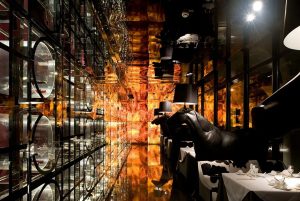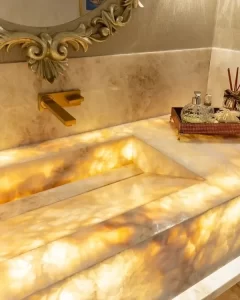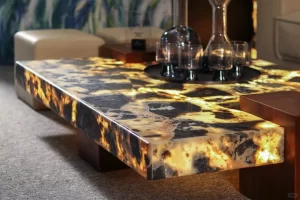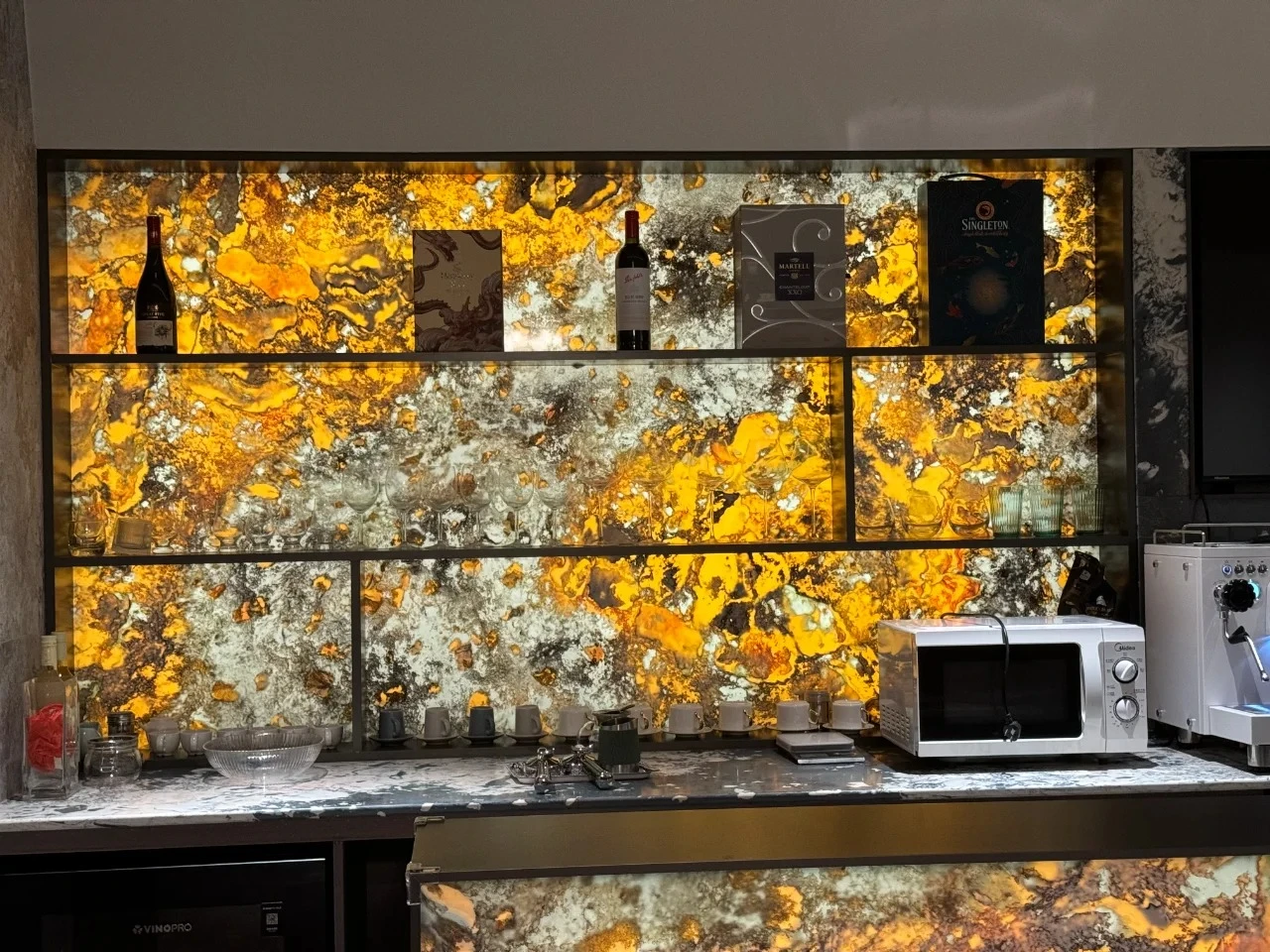Imagine the sun shining through the window into the room, sprinkled on a beautiful stone slab, the stone actually softly transmits light, showing a warm halo. Transparent stone has a magic like this. It is not only a natural piece of beauty but also a “magic stone” in the hands of designers, which may provide the room a certain ambiance. In this article, we will take you to explore several common types of translucent stones, their characteristics, uses, and how to maximize their potential in different design projects.

The light and shadow aesthetic effect of translucent stone
1. Marble: The perfect fusion of classic and modern
As a translucent stone, marble has a long history in the field of design. Particularly with natural patterns, its warm tones and soft textures are well-known. It can display great layers and complexity of beauty after it passes through the light. Whether it is used for wall decoration, countertop design, or floor laying, marble can bring an elegant and luxurious atmosphere.
In modern design, designers often use marble in combination with backlighting. For the bathroom vanity top, for instance, paired with concealed light strips, marble can provide a warm and jade-like texture under the light. This design not only enhances the visual effect of the space, but also increases the overall texture, making people fall for its charm.
2. Agate: A colorful visual feast
If you are eager to add more colors and changes to your design, then agate will be an excellent choice. Natural translucent stone, agate is well-known for its vivid hues and unusual textures. Through light transmission, either warm-toned red agate or cool-toned blue agate can exhibit a dreamy visual effect.
Agate is often used in the decorative design of bar counters or counters. By means of illumination, it may highlight the inherent texture and color variations within the stone, therefore creating a moving visual feast. In addition, in some art installations, designers also like to use agate to create a unique artistic atmosphere, using it as a focal element to attract people’s attention.
3. Quartzite: The perfect combination of durability and aesthetics
Quartzite is a translucent stone that is both beautiful and durable, and is deeply favored by designers and owners. Quartzite is more wear-resistant and tougher than other stones, hence it is quite appropriate for high-frequency use areas like bathroom walls, flooring and counters.
Quartzite has a variety of colors and rich textures, and can be well integrated into various design styles. Its transparent qualities let it exhibit a special sheen under light; both artificial and natural light sources can provide a lot of color to it. Especially in modern minimalist style designs, quartzite can create a fresh and transparent space atmosphere through simple lines and backlighting.
4. Granite: Softness in Solidity
Although Granite is sometimes seen as a tough and durable building material, you might not be aware that it is actually a quite beautiful translucent stone. Particularly those lighter-colored granites, such white and beige variants, can exhibit exquisite crystal formations and natural textures when light penetrates, thereby softening the area.
In design applications, granite is often used for floor and wall decoration. Backlighting accentuates granite’s texture and color shifts, therefore enhancing the whole space’s vibrancy and appeal. Granite’s great durability and hardness also make it a perfect choice for decoration of outdoor area. Granite can give a courtyard path or a garden partition natural appeal.

Translucent stone used in sinks
5. Jade: The perfect combination of luxury and nature
Jade has always been a luxury and nobility emblem. Jade is a translucent stone, hence its place in design is special. Its vivid color variations and soft texture will give the room a sophisticated and enigmatic ambiance. Jade has clear white to rich green and red colors. No matter which tone, it can show a deep beauty through the penetration of light.
In high-end custom design, jade is often used to decorate walls, countertops and art installations. Backlighting helps to properly show jade’s natural color and texture layers, creating an almost unbelievable visual impact. Jade can give a special appeal to anything, from the bedroom of a private house to the lobby of a luxury hotel.
6. Quartz: The new favorite of modern design
As a man-made translucent stone, quartz has become somewhat trendy in the field of design lately. Apart from its natural stone appearance, it boasts better hardness and endurance. The color and texture of quartz can be customized according to needs, making it a perfect match for different design styles.
In interior design, quartz is often used for kitchen countertops, bathroom vanities and wall decorations. Through clever lighting design, quartz can show a delicate gloss, adding a sense of modernity and futurism to the space. Particularly in some minimalist designs, designers now like the clean texture and smooth surface of quartz.
7. Creative application of translucent stone
The application of translucent stone is not limited to traditional interior decoration, it can also show amazing effects in many creative designs. For instance, the chandelier design of the restaurant allows the designer to utilize translucent stone to produce the lampshade and so create a soft and warm dining environment by the light penetration.
In addition, translucent stone is also widely used in modern art installations. To produce erratic light and shadow effects, designers mix these stones with varying hue sources thereby providing the audience with a fresh visual experience.
8. How to choose the right translucent stone
When choosing translucent stone, in addition to considering its aesthetic effect, you also need to pay attention to its physical properties. Different stones are appropriate for different application situations and have variable hardness, wear resistance, and corrosion resistance. For example, although marble is beautiful, it is relatively soft and is more suitable for spaces with strong decorative features, while quartzite is suitable for high-frequency countertops or floors due to its high hardness and durability.
In addition, the color and texture of the stone are also important factors in selection. Select a stone hue and texture that complement the design style and general tone to guarantee that it is in line with other space components.

Translucent stone for tabletops
Whether you are planning a luxury residential project or looking for unique decorative materials for commercial space, translucent stone is an option that cannot be ignored. Apart from their texture and beauty, their skillful utilization of light gives the space a special appeal. Natural stone also gives. From the traditional beauty of marble to the colorful agate to the futuristic sense of quartzite, translucent stone gives designers limitless creative possibilities. If you’re looking for a design material that’s both beautiful and functional, consider incorporating translucent stone into your design plans.
Frequently Asked Question (FAQ)
In what scenarios are translucent stones used?
Translucent stones can be used in many ways, including for decoration and practical purposes. These are several applications for transparent stones:
Translucent stones find application in kitchens, baths, living rooms, and outdoor areas. Backdrops, counters, bathroom walls, fireplace surrounds, and more can all be created from them. Backlighting translucent stones helps to create a brilliant, sophisticated environment.
Art: Translucent stones can be used in art.
Translucent stones find application in light fixtures.
Doors, windows, and skylights: Translucent stone slabs let light enter through yet define areas.
Translucent stones allow bars, boutique hotels, spas, and private clubs to create a luxurious, boutique vibe.
What is Gemstone Transparency? – Global Gem Society
Durable, heat-resistant, and easily cleaned translucent stones are They will make layers of color stand out and improve their look.





